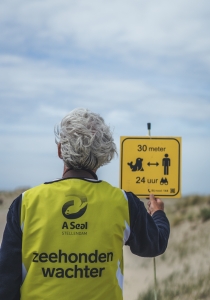Seal guards
You might have already encountered them on the beach. They are recognizable by their brightly colored vests, adorned with the logo of an active seal center: seal guards. In the spring of 2022, the first seal guards in the Netherlands were officially trained.
What’s a seal guard exactly?
Seal guards are specially trained professionals or volunteers who act on behalf of a rescue center along the Dutch coast when seals are reported. Those seals may be sick, injured, or orphaned. Only seal guards are permitted to assess and handle the seal in question when necessary, as stipulated by the Seal Agreement signed in 2020. It is forbidden for those not officially recognized as seal guards, and moreover, it can be dangerous for both humans and animals. The recognition of seal guards greatly helps in protecting seals and preventing beachgoers from handling the seals themselves. Although usually well-intentioned, this unfortunately still happens.
The guards are trained to be the eyes and ears of the experts at the seal center. In the Netherlands, there are three active centers: A Seal in Stellendam, Ecomare on Texel, and Seal Center Pieterburen. We mostly see the seal guards as our heroes of the day. The best living environment for every seal is a healthy sea, and they strive every day to prevent seals from getting into trouble.
No rescue, just rest
Seal wardens can well determine if a seal actually needs help. Often, this is not the case, and the wild animal simply needs peace and space. We can’t say it often enough: the best living environment for every seal is the sea. And this is where the seal guard plays a crucial role. They are well trained in assessing the situation. They maintain close contact with the veterinarians and caregivers at the rescue center. For the collective expertise the best course of action is determined for each individual animal. They are also trained in creating a safe environment for the seal. For instance, they might move the animal in need to a more suitable, quiet place – where the public can’t come.
Education and information
Seal guards are our eyes and ears on the beach when it comes to assessing a seal, but they are also our voice when it comes to interacting with the public along the Zeeland and South Holland coasts. They are the ones who stand next to the public on the beach and provide information about the seal, their habitat, and the policy for seal rescue in the Netherlands.
The training for seal guards
Seal wardens are trained to work safely with and around seals. The training consists of two parts: theory and practice.
The theoretical training includes:
- The characteristics of seals in the Netherlands
- How to recognize any deviations
- How to communicate with the rescue center about these
- How to safely drive and work along the coast
- How to communicate with the public and the regulations regarding seals
The practical training includes:
- How to safely catch a seal
- How to safely place a seal in a transport crate
- How to safely transport a seal
- Stabilizing a seal
- Cooling down a seal
- Freeing a seal from entanglement
Equipped with all this knowledge and skills, seal wardens can start working for the rescue center under whose permit they operate.
What can you do by yourself?
Of course, it can happen that you come across a seal on the beach. What should you do then? Primarily, give the seal peace and space, at least 30 meters. If you find that difficult to estimate: approximately the length of two city buses. Keep your dog on a leash, as a seal bite can also be dangerous for your dog. If you are unsure whether the seal is okay, you can always call 144. They will put you in contact with a seal rescue center. If it turns out that the seal might need help, the rescue center will send a seal warden. The warden might also want to call you to ascertain the location. Afterwards, there will be a period of about 24 hours during which the seal will be observed, unless immediate help is needed.
Regulations
The Seal Agreement has also changed the regulations concerning seals. In the past, anyone who thought a seal was in distress was allowed to move the seal. Now, only officially trained and rescue center recognized seal wardens are permitted to handle seals. It is forbidden for others. This is a good thing, of course, as they are the largest predators in the Netherlands, and even the pups can bite fiercely. Moreover, seals can carry zoonoses, such as viruses. This is precisely why it is part of the regulations that seal wardens must be well trained.
In addition, the decision to take a seal into care is always made by the medically qualified staff of the seal center, such as a veterinarian, who can properly assess the condition of an animal. Thus, the regulations help protect seals and prevent unnecessary rescue.

